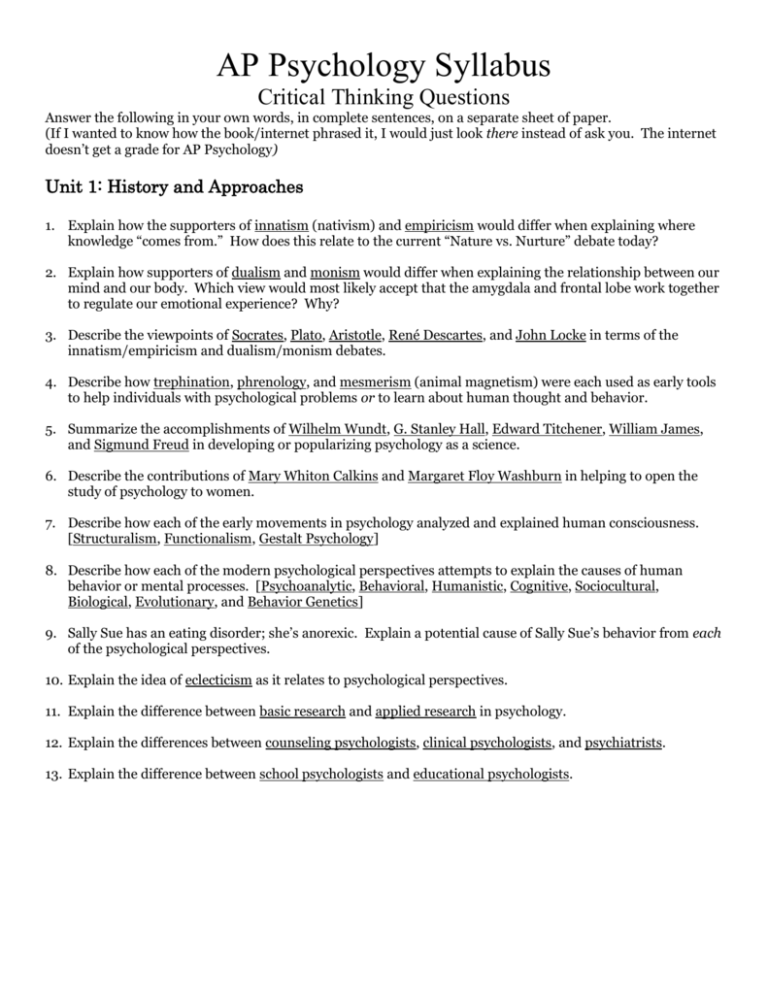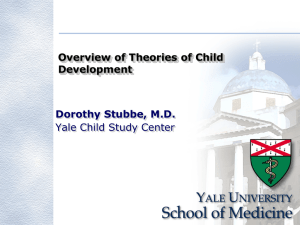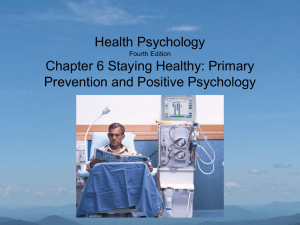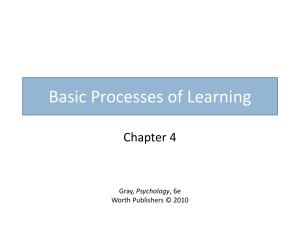Units 1-8 Review Questions - Bremen High School District 228
advertisement

AP Psychology Syllabus Critical Thinking Questions Answer the following in your own words, in complete sentences, on a separate sheet of paper. (If I wanted to know how the book/internet phrased it, I would just look there instead of ask you. The internet doesn’t get a grade for AP Psychology) Unit 1: History and Approaches 1. Explain how the supporters of innatism (nativism) and empiricism would differ when explaining where knowledge “comes from.” How does this relate to the current “Nature vs. Nurture” debate today? 2. Explain how supporters of dualism and monism would differ when explaining the relationship between our mind and our body. Which view would most likely accept that the amygdala and frontal lobe work together to regulate our emotional experience? Why? 3. Describe the viewpoints of Socrates, Plato, Aristotle, René Descartes, and John Locke in terms of the innatism/empiricism and dualism/monism debates. 4. Describe how trephination, phrenology, and mesmerism (animal magnetism) were each used as early tools to help individuals with psychological problems or to learn about human thought and behavior. 5. Summarize the accomplishments of Wilhelm Wundt, G. Stanley Hall, Edward Titchener, William James, and Sigmund Freud in developing or popularizing psychology as a science. 6. Describe the contributions of Mary Whiton Calkins and Margaret Floy Washburn in helping to open the study of psychology to women. 7. Describe how each of the early movements in psychology analyzed and explained human consciousness. [Structuralism, Functionalism, Gestalt Psychology] 8. Describe how each of the modern psychological perspectives attempts to explain the causes of human behavior or mental processes. [Psychoanalytic, Behavioral, Humanistic, Cognitive, Sociocultural, Biological, Evolutionary, and Behavior Genetics] 9. Sally Sue has an eating disorder; she’s anorexic. Explain a potential cause of Sally Sue’s behavior from each of the psychological perspectives. 10. Explain the idea of eclecticism as it relates to psychological perspectives. 11. Explain the difference between basic research and applied research in psychology. 12. Explain the differences between counseling psychologists, clinical psychologists, and psychiatrists. 13. Explain the difference between school psychologists and educational psychologists. Unit 2 Research Methods 1. Why is critical thinking important? 2. Explain the difference between a theory and a hypothesis. 3. Explain why operational definitions and replication are necessary for any psychological research. 4. Describe the methodology and then the advantages and disadvantages of using naturalistic observations, case studies, surveys, and correlational studies. 5. Describe the difference between a sample, a random sample, and a population. 6. Explain how the nonresponse bias and the social desirability bias can affect survey results. 7. Describe the type of information gained by using the longitudinal method and the cross-sectional method. List reasons why each method might be chosen over the other. 8. Compare and contrast the use of lab experiments and field experiments. 9. Describe the relationship between the independent variable and dependent variable in an experiment. 10. Describe the difference between the experimental condition (experimental groups) and the control condition (control groups). 11. Describe the effect of confounding variables on experimental results. Explain how experimenter bias (experimenter expectancy effect), participant bias (demand characteristics), the placebo effect, and the Hawthorne effect act as confounding variables. 12. Explain how random assignment, single-blind procedures, and double-blind procedures eliminate confounding variables. 13. Compare and contrast the quasi-experimental method and the experimental method. List the advantages and disadvantages of using the quasi-experimental method. 14. Explain why each of the ethical guidelines is important for any type of psychological research. [informed consent, freedom to withdraw, “do no harm” (protection from harm), use of deception, debriefing, confidentiality, animal ethics, Institutional Review Board] 15. Compare and contrast descriptive statistics and inferential statistics. 16. For the following data set, calculate the mean, median, and mode, and then briefly describe how you found them. 3, 6, 9, 5, 14, 2, 2, 7, 3, 4, 20, 3 17. Describe how a normal distribution differs from a positively skewed distribution and a negatively skewed distribution making sure to note differences in mean, median, mode, and graphical display of data. 18. How would knowledge of an individual’s z score and percentile for a standardized IQ Test be helpful to find out about his performance on the test? 19. Describe the relationship between the range, variance, and standard deviation of a set of data. 20. The correlation coefficient describing the relationship between “GPA” and “hours of studying” is +0.74 (hypothetically). Describe the strength of the relationship, the direction of the relationship, and what a scatterplot of the data would look like, as well as what this would mean for using the data to predict an outcome. 21. Explain why statistical significance would be important for a study testing the effectiveness of a new medication for those suffering from Schizophrenia. 22. Describe how meta-analysis might be a helpful tool for psychological research. Unit 3 The Biopsychology (The Brain) 1. Describe the purpose of the nervous system. 2. Explain how the different divisions of the nervous system each help individuals understand and react to their environments. [Central, Peripheral, Somatic, Autonomic, Sympathetic, Parasympathetic] 3. Explain how sensory neurons (afferent), motor neurons (efferent), and interneurons normally help individuals to understand and react to their environments. Explain how this process differs when the action is a reflex. 4. Compare and contrast glial cells and neurons. 5. Describe the process of neural transmission including the role of each part of the neuron. [Dendrite, Soma, Nucleus, Axon, Myelin Sheath, Nodes of Ranvier, Axon Terminals, Synaptic Vesicles, Synapse, Neurotransmitters] 6. Describe the polarity of a neuron as it transitions between resting potential, action potential and the refractory period, making sure to describe the actions of sodium ions and potassium ions as the cell depolarizes, repolarizes, and then hyperpolarizes. 7. Describe the difference between excitatory neurotransmitters and inhibitory neurotransmitters in terms of a neuron reaching its threshold. 8. Describe possible effect of an overabundance and a shortage of each neurotransmitter on thinking and behavior. [Serotonin, Dopamine, Noradrenaline (Norepinephrine), GABA (gamma-Aminobutyric acid), Acetylcholine (Ach), Endorphins, Glutamate] 9. Explain how neural transmission is both an electrochemical reaction and uses the all-or-none principle. 10. Describe how each gland helps regulate human functioning. [Pituitary, Pancreas, Thyroid, Adrenal, Pineal, Ovaries, Testes, Parathyroids, Hypothalamus] 11. Explain how an abnormally high level of each hormone would affect human development or functioning. [Human Growth Hormone (HGH), Insulin, Glucagon, Thyroxin, Cortisol, Adrenaline (Epinephrine) & Noradrenaline (Norepinephrine), Melatonin, Estrogen, Progesterone, Testosterone] 12. List 3 technological advances which are effective for examining the structure of the brain, and 3 which are effective for examining the function of the brain. 13. Explain how your life would be different if each structure of your brain disappeared from your head. [Medulla, Pons, Reticular Formation, Cerebellum, Thalamus, Hippocampus, Amygdala, Hypothalamus] 14. Explain how your daily functioning would change if each section of your cerebral cortex were damaged. [Frontal Lobe, Temporal Lobe, Parietal Lobe, Occipital Lobe, Motor Cortex, Somatosensory Cortex, Auditory Cortex, Visual Cortex, Broca’s Area, Wernicke’s Area, Angular Gyrus] 15. Compare and contrast the white matter and grey matter of your brain. 16. Describe the responsibilities of the left and right hemispheres of the brain and the role of the corpus callosum in helping individuals to function properly. Which specific lobes of each hemisphere control each ability? 17. Discuss how the process of brain plasticity (neuroplasticity) gives hope to those who suffer from brain injuries and why some individuals are able to utilize the process more efficiently than others can. Unit 4 Sensation and Perception 1. How does bottom-up processing differ from top-down processing? 2. Describe the process of transduction and list the specific organ or structure responsible for transduction for the senses of taste, smell, hearing, sight, and touch. 3. What are the functions of: Cornea, Iris, Pupil, Lens, Retina, Rods, Cones, Bipolar Cells, Ganglion Cells, Fovea, Optic Nerve 4. What are feature detectors? 5. Describe the relationship between the amplitude and frequency of a light wave and the brightness and the hue of the color seen. 6. Compare and contrast the Trichromatic Theory (Young-Helmholtz theory) and the OpponentProcess Theory for viewing colors. what is an after-image 7. Describe the process of audition (hearing), starting with a sound wave entering the ear and finishing with perception of an auditory stimulus. Auditory Canal [Ear Canal], Eardrum [Tympanic Membrane], Cochlea, Basilar Membrane, Cilia, Hair Cells, Auditory Nerve, Auditory Cortex) 8. Describe the relationship between the amplitude and frequency of a sound wave and the loudness and the pitch of the sound heard. 9. Describe the differences between Place Theory and Frequency Theory in explaining how humans hear the pitch of sounds. 10. Why are taste and smell considered the “chemical senses?” 11. How would an understanding of Gate Control Theory help someone feel better after hurting himself? 12. How would life be different without the vestibular system (equilibrioception) or without the kinesthetic sense (proprioception)? 13. How do absolute threshold, difference threshold, subliminal stimulation, Signal Detection Theory, and selective attention relate to the ability to sense one’s environment? 14. Describe how sensory adaptation causes us to miss signals in the environment 15. Describe each of the Gestalt grouping principles. (Proximity, Similarity, Continuity, Closure, Common Region) 16. How do monocular cues differ from binocular cues 17. Describe the differences in each of the monocular cues. (Interposition, Relative Height, Texture Gradient, Linear Perspective, Relative Size, Light and Shadow,) 18. Describe how the binocular cues of convergence and retinal disparity help to infer depth. 19. What is the visual cliff 20. Describe size, shape, brightness, and color constancies. 21. How could someone’s perceptual set affect the perception of an image? Unit 5: States of Consciousness 1. Describe the cyclical nature and possible functions of sleep. 2. Identify the major sleep disorders. 3. Discuss the content and possible functions of dreams. 4. Discuss hypnosis, noting the behavior of hypnotized people and claims regarding its uses. 5. Discuss the nature of drug dependence. 6. Chart names and effects of depressants, stimulants, and hallucinogenic drugs. 7. Compare differences between NREM and REM. 8. Describe the physiological and psychological effects of depressants, stimulants, and hallucinogens Unit 6: Learning 1. How are classical conditioning and operant conditioning both related to the idea of associative learning? 2. Describe the relationship between each of the basic components of classical conditioning. [NS, UCS, CS, UCR, CR] 3. Briefly summarize the research on classical conditioning done by Pavlov, Watson, Make sure to identify each of the basic components of classical conditioning in the dog experiment 4. Describe the processes of acquisition, extinction, spontaneous recovery, generalization, and discrimination in classical conditioning. 5. Explain how biological predispositions can affect learning through classical conditioning. 6. Summarize the contributions of Thorndike and Skinner to the research on operant conditioning. 7. Explain the difference between negative reinforcement and punishment. 8. Give an original example of each type of reinforcement. [positive, negative, immediate, delayed, primary, conditioned (secondary)] 9. Explain how continuous reinforcement is different from partial (intermittent) reinforcement. In what situation is each most useful? 10. Give original examples for each type of partial (intermittent) reinforcement. [fixed interval, fixed ratio, variable interval, variable ratio] 11. Compare and contrast classical conditioning and operant conditioning, describing the main similarities and differences. 12. Summarize Bandura’s work on observational learning. 13. Explain how the structure of the brain can influence observational learning. 14. Explain how cognition [latent learning, insight, motivation] can influence learning. 15. Explain how behavioral therapies using classical conditioning, operant conditioning, and observational learning can help people with psychological problems. Unit 7: Thinking Memory and Cognition 1. Describe the three stages of memory: encoding, storage retrieval 2. Describe the spacing effect, and the serial-position effect 3. Describe some of the differences between the primacy effect and the recency effect. What effect does each have on retrieval? How long does each last? 4. Contrast iconic memory and echoic memory. 5. Compare and contrast both the capacity and the duration of short-term memory and long-term memory. 6. Describe the ways that stress hormones can affect memory. 7. Distinguish between implicit and explicit memory, and identify the main brain structures associated with the formation of each. 8. Describe the different types of explicit memories, and then give a personal example for each type. [semantic, episodic, flashbulb] 9. Contrast recall, recognition, and relearning as methods of examining memory retention. 10. Explain how retrieval cues help us access stored memories and how the process of priming affects retrieval. 11. Explain how context, mood, and internal states can affect retrieval. 12. Describe the different types of amnesia, including their causes and effects. 13. Explain how proactive interference and retroactive interference can affect retrieval of memories, and then give one personal example for each one. 14. Explain how misinformation and suggestion can distort our memory of an event. 15. Explain how source amnesia (source misattribution) can lead to the formation of false memories. 16. Briefly summarize the contributions made to the study of memory by Hermann Ebbinghaus, Richard Atkinson & Richard Shiffrin, Alan Baddeley, George Sperling, and Elizabeth Loftus. 17. Why should high school students engage in metacognition? 18. What is the purpose of developing concepts? How does the formation of prototypes assist in this purpose? 19. Describe schemas and their purpose in cognition. Why is adaptation necessary for one’s schemas? Describe the two processes of assimilation and accommodation as they relate to the adaptation of our schemas. 20. Explain how each strategy helps us to solve problems or make judgments. In what way is each useful (efficiency, accuracy, etc.) [algorithms, heuristics, insight, trial and error, inductive reasoning, deductive reasoning]? 21. How is convergent thinking different from divergent thinking? Discuss situations in which each might be used. How are these related to creativity? 22. Explain how hindsight bias, the false consensus effect, overconfidence, confirmation bias, belief bias, belief perseverance, fixation, and the Dunning-Kruger Effect lead people to make decisions or judgments that are inaccurate. 23. How does framing affect decision-making? 24. How does each of the following heuristics sometimes mislead individuals, causing them to make decisions or solve problems incorrectly? [availability heuristic, representativeness heuristic, anchoring heuristic] 25. What is the self-fulfilling prophecy, and why should people be aware of this phenomenon? 26. Describe the structural components of language. 27. Describe the components of grammar. 28. Describe the process of language development in the first few years of life. 29. Compare and contrast the various theories on how language is developed. [behaviorist theory (Skinner), nativist theory (Chomsky), critical periods] 30. Describe the relationship between language and thinking. 31. Describe how each of the following are crucial for language use [Broca’s area, Wernicke’s area, visual cortex, angular gyrus, motor cortex, auditory cortex]. Unit 8: Motivation and Emotion 1. Describe each of the basic theories of motivation. (Instincts & Evolutionary Theory, Drive-Reduction Theory, Incentive Theory, Arousal Theory, Hierarchy of Needs) 2. Explain how parts of the brain and chemicals in the body influence hunger and bodily functioning in relation to food. (Lateral Hypothalamus, Ventromedial Hypothalamus, Insulin, Glucagon, Orexin, Ghrelin, Obestatin, Leptin, PYY) 3. What is the body’s set point? What factors influence set point, and how are these factors related to metabolism and basal metabolic rate? 4. What are psychological and social influences which are related to taste preferences and hunger overall? 5. What is the difference between anorexia nervosa and bulimia nervosa? What are physiological and psychological factors which can contribute to these eating disorders? 6. What is obesity? What are physiological and psychological factors which can contribute to obesity? 7. What is the sexual response cycle? 8. What is sexual orientation? Describe the different orientations (heterosexual, homosexual, bisexual). 9. What correlations between homosexuality and physiological, social, or psychological factors have researchers identified? 10. What is social ostracism, and why is it such an aversive stimulus for human beings? 11. What is involved when someone experiences flow? 12. What are characteristics of people with lower and higher levels of achievement motivation? 13. What is the difference between intrinsic and extrinsic motivation? How is the overjustification effect related to motivation? 14. Describe the different employee engagement styles and management/leadership styles. (Engaged, Not Engaged, Actively Disengaged, Task Leadership, Social Leadership, Theory X, Theory Y) 15. Describe the basic struggle in each of the social conflict situations. Give an example of each from your life. (Approach-Approach, Avoidance-Avoidance, Approach-Avoidance, Multiple Approach-Avoidance) 16. What are the three basic components of emotion? 17. Describe each of the basic theories of emotion. Pick an example of an emotional situation, and explain it from the perspective of each of the theories. (James-Lange Theory, Cannon-Bard Theory, Schachter-Singer Two-Factor Theory, Opponent-Process Theory, Cognitive-Appraisal Theory) 18. Explain the relationship between emotions and the autonomic nervous system. 19. What parts of the body are important in terms of nonverbal communication? 20. In what ways are emotions universal? In what ways is emotion influenced by an individual’s culture? 21. Explain how emotion both affects and is affected by behavior? 22. How do emotions differ in terms of valence and arousal? 23. What are some factors which contribute to or hinder happiness? 24. Describe how the three types of stressors contribute to overall stress level. (Catastrophes, Significant Life Changes, Daily Hassles) 25. Describe the General Adaptation Syndrome (GAS), discussing the physiological effects at each stage. (Alarm Reaction, Resistance, Exhaustion) 26. Describe how stress is related to physiological functioning of the body. 27. What are different ways that people use to cope with stress?









